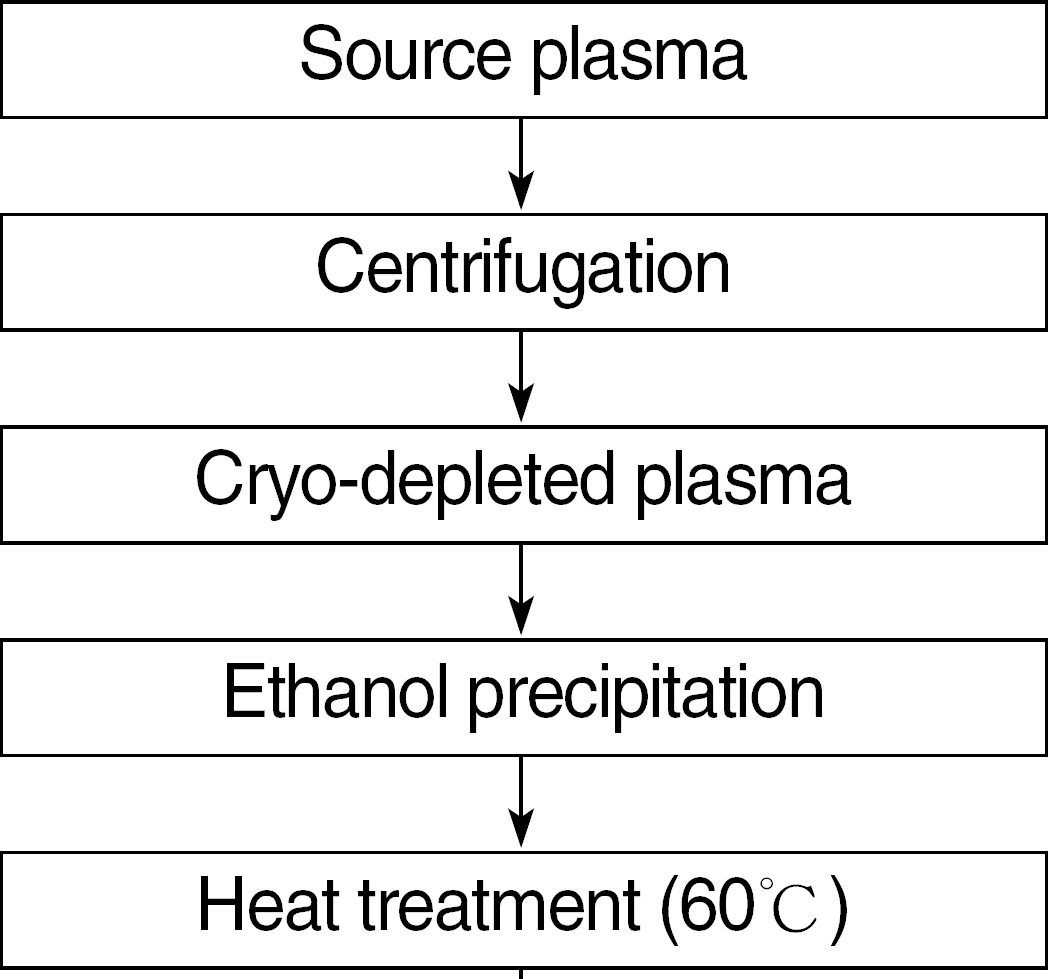Korean J Lab Med.
2010 Feb;30(1):45-50. 10.3343/kjlm.2010.30.1.45.
Evaluation of the Virus-elimination Efficacy of Nanofiltration (Viresolve NFP) for the Parvovirus B19 and Hepatitis A Virus
- Affiliations
-
- 1Blood Transfusion Research Institute, Korean Red Cross, Seoul, Korea. dj57_2000@redcross.or.kr
- 2Central Blood Test Center, Korean Red Cross, Seoul, Korea.
- 3Department of Biological Sciences, Hannam University, Daejeon, Korea.
- KMID: 1096818
- DOI: http://doi.org/10.3343/kjlm.2010.30.1.45
Abstract
- BACKGROUND
The safety of plasma derivatives has been reinforced since 1980s by variable pathogen inactivation or elimination techniques. Nucleic acid amplification test (NAT) for the source plasma has also been implemented worldwide. Recently nanofiltration has been used in some country for ensuring safety of plasma derivatives to eliminate non-enveloped viruses such as parvovirus B19 (B19V) and hepatitis A virus (HAV). We evaluated the efficacy of nanofiltration for the elimination of B19V and HAV.
METHODS
To verify the efficacy of nanofiltration, we adopted a 20 nm Viresolve NFP (Millipore, USA) in the scaling down (1:1,370) model of the antithrombin III production. As virus stock solutions, we used B19V reactive plasma and porcine parvovirus (PPV) and HAV obtained from cell culture. And 50% tissue culture infectious dose was consumed as infectious dose. The methods used to evaluate the virus-elimination efficacy were reverse-transcriptase polymerase chain reaction for B19V and the cytopathic effect calculation after filtration for PPV and HAV.
RESULTS
B19V was not detected by RT-PCR in the filtered antithrombin III solutions with initial viral load of 6.42x10(5) IU/mL and 1.42x10(5) IU/mL before filtration. The virus-elimination efficacy of nanofiltration for PPV and HAV were > or =10(3.32) and > or =10(3.31), respectively.
CONCLUSIONS
Nanofiltration would be an effective method for the elimination of B19V and HAV. It may be used as a substitute for NAT screening of these viruses in source plasma to ensure safety of plasma derivatives in Korea.
MeSH Terms
Figure
Reference
-
1.Mosley JW., Rakela J. Founding viruses and transfusion medicine. Transfusion. 1999. 39:1041–4.2.World Health Organization. Recommendations for production, control and regulation of human plasma for fractionation. WHO Technical Report Series 941. WHO expert committee on biological standardization. Genava: WHO;2007.3.Horowitz B. Blood protein derivative viral safety: observations and analysis. Yale J Biol Med. 1990. 63:361–9.4.Blümel J., Schmidt I., Effenberger W., Seitz H., Willkommen H., Brackmann HH, et al. Parvovirus B19 transmission by heat-treated clotting factor concentrates. Transfusion. 2002. 42:1473–81.
Article5.Wu CG., Mason B., Jong J., Erdman D., McKernan L., Oakley M, et al. Parvovirus B19 transmission by a high-purity factor VIII concentrate. Transfusion. 2005. 45:1003–10.
Article6.Chudy M., Budek I., Keller-Stanislawski B., McCaustland KA., Neidhold S., Robertson BH, et al. A new cluster of hepatitis A infection in hemophiliacs traced to a contaminated plasma pool. J Med Virol. 1999. 57:91–9.
Article7.Committee for Proprietary Medicinal Products. Note for guidance on virus validation studies: the design, contribution and interpretation of studies validating the inactivation and removal of viruses. http://www.emea.europa.eu/pdfs/human/bwp/026895en.pdf. (Update on Feb. 1996.8.Webert KE., Cserti CM., Hannon J., Lin Y., Pavenski K., Pendergrast JM, et al. Proceedings of a consensus conference: pathogen inactivation-making decisions about new technologies. Transfus Med Rev. 2008. 22:1–34.
Article9.Yokoyama T., Murai K., Murozuka T., Wakisaka A., Tanifuji M., Fujii N, et al. Removal of small non-enveloped viruses by nanofiltration. Vox Sang. 2004. 86:225–9.
Article10.Kleinman SH., Glynn SA., Lee TH., Tobler L., Montalvo L., Todd D, et al. Prevalence and quantitation of parvovirus B19 DNA levels in blood donors with a sensitive polymerase chain reaction screening assay. Transfusion. 2007. 47:1756–64.
Article11.Parsyan A., Candotti D. Human erythrovirus B19 and blood transfusion-an update. Transfus Med. 2007. 17:263–78.12.Soucie JM., Robertson BH., Bell BP., McCaustland KA., Evatt BL. Hepatitis A virus infections associated with clotting factor concentrate in the United States. Transfusion. 1998. 38:573–9.
Article13.Lawlor E., Graham S., Davidson E., Yap PL., Cunningham C., Daly H, et al. Hepatitis A transmission by factor IX concentrates. Vox Sang. 1996. 71:126–8.
Article14.U.S. FDA. Viral clearance processes for plasma derivatives. Guide to inspections of viral clearance process for plasma derivatives. http://www.fda.gov/ICECI/Inspections/InspectionGuides/ucm074866.htm. (Update on Nov 2009).15.Committee for Proprietary Medicinal Products. Note for guidance on plasma-derived medical products. http://www.emea.europa.eu/pdfs/human/bwp/026995en.pdf. (Update on Jan. 2001.16.Furuya K., Murai K., Yokoyama T., Maeno H., Takeda Y., Murozuka T, et al. Implementation of a 20-nm pore-size filter in the plasma-derived factor VIII manufacturing process. Vox Sang. 2006. 91:119–25.
Article17.Kasper CK, Costa e Silva M, editors. Registry of clotting factor concentrates. 6th ed.Quebec: World federation of hemophilia;2005. p. 1–9.18.Japanese Red Cross Plasma Fractionation Center. Receipt inspection/virus inactivation and removal. http://www.pfc.jrc.or.jp/01/05.html. (Update on Sep. 2009.
- Full Text Links
- Actions
-
Cited
- CITED
-
- Close
- Share
- Similar articles
-
- Relationship between Myelodysplastic Syndrome and Epstein-Barr Virus or Human Parvovirus B19 Infection
- Detection of Human Parvovirus B19 in Human Blood by Polymerase Chain Reaction
- Prevention of Viral Hepatitis and Vaccination
- Transfusion-Transmitted Diseases: Current State and Recent Countermeasures
- Human Parvovirus B19 Infection in Patients with Fibromyalgia


